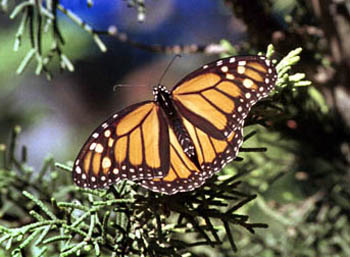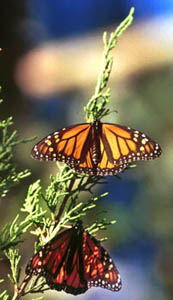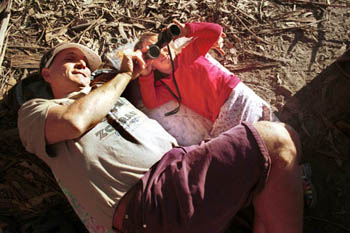![[MetroActive News&Issues]](/gifs/news468.gif)
[ Santa Cruz | MetroActive Central | Archives ]
Butterfly Brouhaha
How a school, a church and monarch butterflies struggle to coexist in an exclusive West Side neighborhood
By Andrea Perkins
Photographs by George Sakkestad
AT FIRST GLANCE, the Oblates of St. Joseph seems a peaceful enough place. A Roman Catholic shrine located on West Cliff Drive, it overlooks the Monterey Bay and Lighthouse Field, where about 35,000 monarch butterflies are roosting this winter. Also located on the Oblates' seven-acre property is Gateway School, the shrine's tenant; to the north and east rest the picturesque homes of the West Cliff neighborhood. But now the shrine's parking lot expansion project, which has been on the table for a year and a half, has turned this serene corner of the world into a battlefield, Santa Cruz-style.
On one side are those who question the wisdom of building more parking lots anywhere, especially next door to the Monterey Bay National Marine Sanctuary and a state park, home to diverse species of birds and to monarch butterflies. Also on this side are surfers who point out that their sanctuary, the world-renowned Steamer's Lane, will be adversely affected by grease and oil runoff from an increase in pavement.
Neighbors, some of whom stand to lose their ocean views, fear the effects of increased traffic congestion in their neighborhood. Many of the above believe that Santa Cruz City staff have failed to acknowledge a environmentally sensitive habitat in flagrant disregard of the city's Coastal Plan.
On the other side are those who support the church's plan. They point to experts who say the parking lot will have no impact on the butterflies. They mention that the church intends to plant nectar sources for the butterflies around the lot. They accuse neighbors of using the butterflies to hide their NIMBY attitudes. And then there are those closely aligned with the church who feel like victims of religious persecution for what they see as a harmless request to accommodate an expanding congregation.
"All the worst parts of Santa Cruz politics have filtered into this," says Councilmember Mark Primack, who was the architect for the Oblates' chapel, "divisiveness, rumor-mongering. I think it's important for this city to get past this kind of antagonism. ... There are no good and bad guys, only people trying to coexist."
Lots of Problems
IN THE EARLY '50s, the Oblates harbored dreams of constructing a national shrine, a great and glorious cathedral in honor of St. Joseph that would attract pilgrims from all over the world. Lacking the funds to realize this vision, the Oblates sold chunks of land along Eucalyptus Avenue for use as residential lots. With the proceeds, the Oblates built a much humbler structure, which was used for about 40 years until there were enough funds to build the chapel that graces the spot today.
Now Father Philip Massetti hopes to double his congregation's 204-seat capacity. In order to do so legally, he must also expand his parking lot, which is shared by Gateway, to 147 spaces. However, if the Santa Cruz City Council allowed for a complete overlap of Gateway School use and church use (which rarely coincide), the existing 100-space parking lot could already support 350 churchgoers under the local ordinance, which requires one parking space for every 3.5 persons. This is the latest proposal voiced by Dennis Kelly, a Lighthouse Avenue resident and lawyer who is leading the appeal against the Oblates proposal (which will be heard by the council at its Jan. 23 meeting).
"We haven't decided what to do about the compromise," says Oblates' land-use consultant Deidre Hamilton, who says she took on the project only after the Oblates assured her it wouldn't be controversial. "There is no compromise if they want to leave it an open field, if they want it to be an extension of Lighthouse Field, which, by the way, has a parking lot."
Hamilton swears that the last thing she's trying to do is "rape and pillage the poor butterflies" and says she sympathizes with the neighbors who fought to save Lighthouse Field from becoming a convention center years ago.
"Some people say you don't need those extra pews, because there aren't enough people to fill them yet," she says, "but I don't know if I would agree with that. It's like telling somebody who is remodeling their house that they don't need that extra bedroom."
The Oblates have made no secret of their intention to do some of their own remodeling by constructing a social hall at some unspecified point in the future. In a letter to the city planner, Hamilton even states that the new parking lot "would also accommodate the future relocation of the church hall. Since it will be part of the church use, no additional parking would be required."
Father Massetti has said repeatedly that funds for this hall still need to be raised. But because the future hall's dotted outline appears on the application, critics such as Kelly and the Sierra Club's Mark Massarra call this a phased project in bold defiance of the California Environmental Quality Act, which prohibits projects from being submitted in separate chunks, thereby sidestepping environmental review.
The Negative Declaration, which is the Planning Department's version of an Environmental Impact Report, says that the hall can't be considered a "probable future project" since "there are no site plans, building sizes or proposed uses from which a future project could be evaluated."
The Oblates' proposed plan not only suggests an attempt to clear hurdles to a future social hall project but also seems more concerned with where parking on the property takes place than with how much of it is made available to potential churchgoers. In letters to the Zoning Board and neighbors dated Nov. 29, 1999, and Feb. 28, 2000, Father Massetti writes forthrightly of his wish to "make our property more pilgrim-friendly during the next year" and expresses concerns about the school's current use of the parking lot.
Because of a neighborhood uproar in 1998 concerning increasing Gateway school traffic on Eucalyptus Avenue, the Oblates allowed the school to use the area around the bronze statue in front of the shrine as a drop-off/pick-up area for students, explains Father Massetti, "hoping that it would be for a short period of time."
At the heart of this battle is traffic: neither church or neighbors want to be disturbed by the twice-daily transportation needs of the school's approximately 300 students. In his letters, Father Massetti, who did not return Metro Santa Cruz's calls, explains that by relocating the drop-off/pickup area in the expanded parking lot away from the rectory, with an entrance and exit onto Pelton Avenue, the Oblates would be able to "re-landscape [their] garden area, to make it more conducive to prayer and meditation," giving it "the potential for becoming a real showcase for Santa Cruz."
ACCORDING TO Ralph Meyberg, a neighbor adamantly opposed to the parking lot expansion, Santa Cruz already has a real showcase: the monarch butterfly population that clusters fewer than 100 feet away from where Father Massetti hopes to expand his parking lot.
"If people can't see the environmental importance of protecting these miraculous creatures," Meyberg says, "I hope they can at least see the economic importance. ... The monarchs are a great ecotourism opportunity for the city."
Like Meyberg, many say that the parking lot itself, while paving over approximately half an acre of open space, won't threaten the bewinged bugs as much as the intensified traffic it will create along Pelton Avenue. But that's a consequence that the city's Negative Declaration, which gives the project an almost unilateral vote of "no impact" on everything from wildlife to transportation circulation, ignores.
Supposing only 250 out of 300-plus students get dropped off and picked up every day, that would still create one thousand additional car trips a day along Pelton, a conservative estimate that already has neighbors concerned about accidents, pollution and an increased butterfly mortality rate.
The Negative Declaration also describes the church site as being "located in an urbanized area surrounded by development," though the city's Coastal Plan clearly defines the area encompassing Lighthouse Field, Steamer's Lane and the Oblates' property as an environmentally sensitive habitat area.
The Oblates' did hire a butterfly expert, Elizabeth Bell, to conduct the further study that the Coastal Plan says is needed within this area to determine precise habitat areas. Her study showed that the parking lot itself would have little or no effect on the wintering butterflies. Public outcry prompted the city to hire another expert, who corroborated Bell's study.
Kelly then gathered testimonies from two more experts, one of whom, Travis Longcore of Land Protection Partners, warned that "road kill is an important source of mortality for overwintering monarchs," equating it to the rate of death from predation by birds.
Here is what happens: Strong winds toss butterflies from their clusters. Often, they land on nearby Pelton Avenue, 25 feet from their roosting spot. Butterflies are only able to fly when it's warm. If it's too cold for them to fly and they end up on the asphalt where there are no long grasses for them to crawl onto for safety, they are often crushed by passing vehicles.
"This isn't about neighbors against a parking lot," Meyberg argues. "This is about the problem of terminating a miracle. We're talking about an ecosystem here. Private property is of little consequence to wildlife. The only effect it has on them is that it kills them."
Meyberg is also concerned about falcons and the eight sea otters and two pups now living in the bay that, along with surfers, could be affected by oil and grease runoff from additional pavement. In light of such concerns, environmentally friendly alternatives to asphalt, such as crushed granite, were proposed but shot down due to maintenance issues. However, grease traps will be required if the parking lot is built, though critics claim they are ineffectual during heavy rains.
Miraculous Migration
THE MONARCH is the only insect known to migrate. It may even be the only multigenerational migrating creature in the world. The monarch's yearly migration from the interior United States and Canada to the California coast and parts of Mexico is a riddle scientists have yet to solve.
Explanations of the migration include butterfly genetics, the sun's rays and the Earth's electromagnetic field. The butterflies weighing down branches this year are the great-great-grandchildren of the ones who did so the year before, in some cases on the very same trees. That's some pretty amazing migratory behavior for an insect, "rivaling bird and mammal migrations in predictability and distance," according to The Monarch Project, a document put out by the Xerces Society.
"The monarchs are these beautiful things that flutter through our lives," says Pat Matejcek, vice chairperson of the Santa Cruz chapter of the Sierra Club. "As a culture, we haven't come to terms with the fact that there are other creatures here with very simple needs, like water and nectar. You can't redevelop their habitat area and give them an affordable housing alternative. There used to be elk and grizzly bear in California. Luckily, they're still part of the world, but butterflies can't get happy hanging in Wyoming. We're trying too hard to jam our foot into the glass slipper that living on the coast is all about. I personally wish the church had a more embracing view and realized where they have to pull in their horns on their expansionism, like we're asking everyone to do. Why should they be exempt because they are a church?"
Like almost all species that aren't human, migrating monarchs are in decline, largely because 44 percent of the forests that shelter monarchs during the winter in Mexico have been destroyed in the past 29 years. Due to unchecked urban development, some migrating monarchs have disappeared altogether in some places, like Pacific Grove. Scientists are now calling the migration an "endangered phenomenon."
Tougher Than They Look
WAYNE SHAFFER, neighbor and frequenter of the church, didn't "know it was against the law to build a parking lot. We're just trying to add a little parking," he says. "They make it sound like the worst thing that could possibly happen." Shaffer feels that the parishioners are an asset to the community that are being treated unfairly. "We're being scrutinized, and I feel like we're being attacked somewhat in our faith," he says.
This kind of issue has caused sparks to fly above the City Council. Primack points out that the Oblates' parcel is the least-developed in the neighborhood. "If we held neighbors to the same standards, they'd be living in far smaller houses," he says.
Meanwhile, Vice Mayor Christopher Krohn echoes environmentalists by suggesting such solutions as carpooling, construction of a significantly smaller parking lot or relocating the lot to the other side of the church. Krohn also wonders, "Might the Diocese allow St. Joseph permission [agree to a request] to expand Sunday mass from one mass to two masses?" Both Krohn and Primack agree that protecting butterfly habitat is a priority.
For a butterfly expert, Trond Toft has stayed remarkably clear of the Oblates brouhaha. He guesses it might be because he doesn't have a Ph.D. But Toft, who has been a docent at Natural Bridges for seven years, does knows his butterflies.
Not only is he a fountain of knowledge on every aspect of butterfly behavior, but he has also developed a system of counting them. A high-class insect photographer, he lets butterflies build cocoons inside his lushly vegetated Beach Flats home. He has fixed broken wings with super glue, an experiment that actually worked. Once he even took a convalescing critter out drinking with him, exciting a waitress to such an extent that she accidentally dropped the butterfly into a sink of dirty dishes. Luckily, after it dried off it was just fine and survived through mating season. Maybe monarchs are tougher then they look.
Toft agrees with the other experts that Lighthouse Field is gaining on Natural Bridges as Santa Cruz's premier monarch wintering habitat. He attributes the decrease in the monarch population at Natural Bridges in recent years to the loss of roosting trees to pine pitch canker and severe storms. But he also says that the very people who come to see the butterflies may be playing a part in their disappearance.
"There are various types of predators at Natural Bridges," he says, "[and] an unusual amount of wasps, which has to do with picnickers. There is little wasp food in Lighthouse Field, but wherever you find bologna sandwiches, you'll find wasps." Wasps attack butterfly clusters, killing and eating the dormant insects.
Toft, a tall man with a ponytail, bends down and scoops a faltering monarch up off the asphalt of Pelton Avenue, which after last night's minor rain is littered with butterfly carcasses. He is careful not to touch its brilliant wings. "They can't fly when it's cold like this," he says, cupping his hands around the bug and blowing gently into a small opening between his finger and thumb. After a few seconds, he opens his hands and the monarch flutters fiercely in the heart of the nearby cluster.
[ Santa Cruz | MetroActive Central | Archives ]
Copyright © Metro Publishing Inc. Maintained by Boulevards New Media.
![]()

 Insect Royalty
Insect Royalty

Flutter Family: Doug Greenfield and his daughter Grace enjoy butterfly-watching at Lighthouse Field.
From the January 17-24, 2001 issue of Metro Santa Cruz.